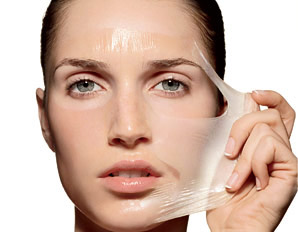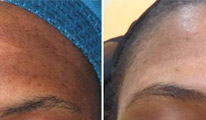Chemical Peeling
 We have expertise in:
We have expertise in:
- Acne scars treatment
- Aesthetic laser treatments
- Botulinum
- Chemical peeling
- Dermaroller
- Dermal Fillers
- Exilis treatment
- Exilis Elite treatment
- HIFU
- INTRAcel Microneedling Treatment
- IntraGenT GRFT Skin Tightening
- Laser hair removal
- Laser treatment for birthmarks
- Laser tattoo removal
- Laser helmet for hairloss
- Thread Lift
- Tribeam Laser Toning
- Ultracel Non Surgical Facelift
- Weight Loss & Slimming
 A chemical peel is a skin-resurfacing procedure in which a chemical solution is applied to skin to peel away the top layers. The skin that grows back after a chemical peel is smoother and younger looking.
A chemical peel is a skin-resurfacing procedure in which a chemical solution is applied to skin to peel away the top layers. The skin that grows back after a chemical peel is smoother and younger looking.
Chemical peels are used to treat wrinkles, skin discoloration and scars - typically on the face. A chemical peel can be done alone or in combination with other cosmetic procedures.
Chemical peels can be done at different depths - light, medium or deep - depending on your desired results. Each type of chemical peel uses a different chemical solution. Deeper chemical peels produce more-dramatic results, but also involve longer recovery times.
A chemical peel can be used to treat various skin problems. Depending on the issues you're addressing with the procedure, you'll choose a chemical peel in one of three depths:
- Light chemical peel - a light, or superficial, chemical peel removes the outer layer of skin (epidermis). It can be used to treat fine wrinkles, acne, uneven skin tone and dryness. You might have a light chemical peel as often as once a week for up to six weeks - depending on your desired results.
- Medium chemical peel - this type of chemical peel removes skin cells from the epidermis and from portions of the upper part of your middle layer of skin (dermis). A medium chemical peel can treat wrinkles, acne scars and uneven skin tone. You might repeat a medium chemical peel every six to 12 months to maintain results.
- Deep chemical peel - a deep chemical peel removes skin cells from the epidermis and from portions of the mid to lower layer of your dermis. Your doctor might recommend a deep chemical peel if you have deeper wrinkles, scars or precancerous growths.
A chemical peel can't eliminate deep scars or reduce the size of pores.
Before you have a chemical peel, your doctor will likely:
- Review your medical history. Be prepared to answer questions about current and past medical conditions - especially any heart, kidney or liver conditions if you're considering a deep chemical peel. Tell your doctor about any medications you're taking or have taken recently - particularly those that might make your skin sensitive to the sun - as well as any cosmetic procedures you've had in the past. Be sure to tell your doctor if you've been using a retinoid cream (tretinoin), which can enhance the penetration of some chemical peels.
- Do a physical exam. Your doctor will inspect your skin and the area to be treated. This will help him or her determine what type of chemical peel you might benefit from most and how your physical features - for example, the tone and thickness of your skin - might affect your results.
- Discuss your expectations. Talk with your doctor about your motivations and expectations, as well as the potential risks. Make sure you understand how many treatments you might need, how long it'll take to heal and what your results might be.
If you decide to proceed with the chemical peel, you might also need to:
- Take antiviral medication. If you have a history of herpes infections around your mouth, your doctor will likely prescribe an antiviral medication before and after treatment to help prevent a viral infection.
- Use glycolic acid lotion. If you're having a light chemical peel using glycolic acid, your doctor might recommend using a glycolic acid lotion for two weeks before treatment to ensure a more uniform peel. Using the lotion ahead of time also helps you find out if you're sensitive to glycolic acid.
- Use a retinoid cream. If you're having a light or medium chemical peel, your doctor might recommend using a retinoid cream (tretinoin) beforehand to shorten your treatment time and speed the healing process but retinoid creams need to be stopped 3 days before peel.
- Use a bleaching agent. Your doctor might recommend using a bleaching agent (hydroquinone) and a retinoid cream (tretinoin) before or after the procedure to prevent skin darkening.
- Avoid unprotected sun exposure. Too much sun up to two months before the procedure can cause permanent irregular pigmentation in treated areas. Discuss sun protection and acceptable sun exposure with your doctor.
- Avoid makeup and hair products. Your doctor might recommend avoiding cosmetics, moisturizer and hair products - such as conditioner, mousse and hair spray - for 24 hours before a medium or deep chemical peel.
Chemical peels are used to treat certain skin conditions or for aesthetic improvement. Fine lines under the eyes or around the mouth and wrinkles caused by sun damage, aging, and hereditary factors can often be reduced or eliminated with this procedure. Sags, bulges, and more severe wrinkles do not respond well to chemical peels. They may require other cosmetic surgical procedures, such as carbon dioxide laser resurfacing, a face lift, brow lift, eye lift, or soft tissue filler. A dermatologic surgeon can help determine the most appropriate type of treatment for each individual.
Chemical peels are performed on the face, neck or hands. They can help reduce:
- certain types of acne
- mild scarring
- sun spots
- age spots
- liver spots
- freckles
- dark patches due to pregnancy or taking birth control pills (melasma)
Chemical peels can also help skin that is dull in texture and color.
Areas of sun damage, which may contain pre-cancerous keratoses that appear as scaly spots, may improve after chemical peeling. Following treatment, with diligent sun avoidance and sunscreen use, new pre-cancerous lesions are less likely to appear.
A chemical peel can be performed in a doctor's office or in a surgery center as an outpatient procedure. The skin is thoroughly cleansed with an agent that removes excess oils, and the eyes and hair are protected. One or more chemical solutions, such as glycolic acid, trichloroacetic acid, salicylic acid, lactic acid, or carbolic acid (phenol), are applied to the skin.
Prior to the chemical peel, your doctor may ask you to stop taking certain drugs, and prepare your skin with topical preconditioning medications such as Retin-A®, Renova®, or glycolic acid. After the chemical peel, it's important to use a broad-spectrum sunscreen every day.
24 hours before procedure: If you have been prescribed oral antibiotics or an oral antiviral medicine, you should begin taking those.
Day of peel: You will need preparation time for washing and scrubbing. Additionally, you will also need time for any sedation (which is optional). Remember: Ask your doctor if you need to have someone drive you home.
During a chemical peel, the physician applies the solution to small areas on the skin. These applications produce a controlled wound, enabling new, regenerated skin to appear.
During the procedure, most patients experience a warm to somewhat hot sensation that lasts about five to 10 minutes, followed by a stinging sensation. Cool compresses may be applied to help alleviate this stinging. A deeper peel may require pain medication during or after the procedure.
Depending upon the type of chemical peel, a reaction similar to sunburn occurs following a chemical peel. Peeling usually involves redness, followed by scaling that ends within three to seven days. Mild peels may be repeated at one to four-week intervals until the desired clinical effect is achieved.
Medium-depth and deep peeling may result in swelling and the presence of water blisters that may break, crust, turn brown, and peel off over a period of seven to 14 days. Medium-depth peels may be repeated in six to twelve months, if necessary.
You will work with your dermatologist to determine the depth of your peel. This joint decision can vary, depending upon the condition of your skin and the objectives of treatment.
After treatment, some peels may require bandages to be placed on part or all of the skin that is treated. Bandages are usually removed in several days and may improve the effectiveness of the treatment.
It is necessary to avoid over-exposure to the sun after a chemical peel since the new skin is fragile and more susceptible to complications. The dermatologic surgeon will prescribe the proper follow-up care to reduce the tendency to develop abnormal skin color after peeling.




